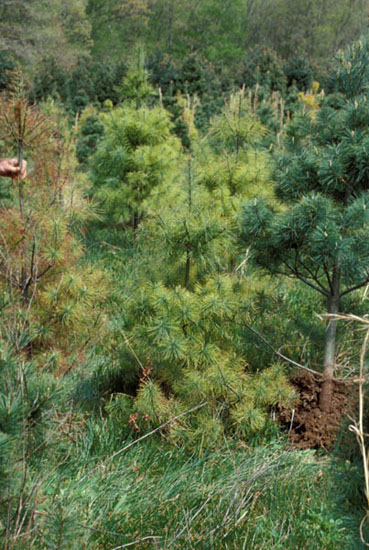Issue 3, May 8, 2009
White Pine Problems
Over the last 25 or more years, white pine samples have arrived at the Plant Clinic fairly regularly. The problem is an apparently sudden change from healthy, dark green foliage to pale, sickly looking foliage. This early in the season growers complain that affected white pines are growing very slowly or appear dead like the one in the image.

Of course, most want to blame this condition on a plant disease. That would be fine with me too, if I could find one to blame. For the record, white pines are not common hosts for pinewood nematodes. Yes, we have found pinewood nematodes on a couple of white pines over the last thirty years, but these trees were already near death. It is thought that the nematodes were secondary in those few cases. It is highly unlikely that pinewood nematodes are involved in your white pine problems.
There are few needle blight diseases on white pine. Additionally, if there were, you would certainly see spots, band, or fruiting bodies. Incubated tissue yields nothing pathogenic. Keep in mind that all plant material will rot when you incubate it long enough. Fungal pathogens will show their fruiting bodies or spores in 24-48 hours of incubation.
Two root rots do affect white pine. Both require poor drainage and extended wet soil conditions. Phytophthora and Procerum are found in these conditions and cause black, soft root rot. Both are also considered to be secondary to the site problems listed.
So, what is causing the decline of many white pines in Illinois? The Plant Clinic staff has assayed samples for the presence of pinewood nematodes; has cultured for fungal pathogens of needles, stems, and roots; and inspected for insect infestations or injuries. The only common factor seems to be root decline. Few live white roots have been found, but fungal pathogens cannot be correlated with poor rooting. It appears that roots are on the decline for other reasons. Some possibilities include heat, drought, flooding, deep planting, and sudden extremes in temperature and moisture. The image shows the difference between a healthy white pine root system and one from a tree with decline.

Because these problems in white pine are not usually the result of an infectious disease, immediate removal of the tree is not necessary. Instead, try to keep the tree watered in periods of drought, and see how it responds. Also, try digging into a bit of the root system for a better picture of the situation. If roots are brown in cross-section and the outer layer easily pulls off or is not present, then root injury has occurred. If the roots are white and healthy, then the problem is aboveground and our theory is wrong, at least in your case.
Another factor that may be involved in Illinois is the pH of the soil. Our landscape soils have a fairly high pH level whereas pines prefer more acid soils. It may be helpful to fertilize with an acidic fertilizer specifically packaged for pines or acid loving plants. Follow the directions so as not to burn the roots by applying too much fertilizer. Fertilization is usually recommended in early spring or late fall. --Nancy Pataky
Author:
Nancy Pataky